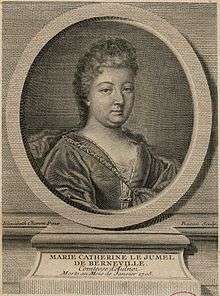Madame d'Aulnoy
| Madame d'Aulney, Baroness d'Aulnoy | |
|---|---|
 Marie-Catherine d'Aulnoy | |
| Born |
Marie-Catherine Le Jumel de Barneville 1650/1651 Barneville-la-Bertran |
| Died | 4 January 1705 |
| Occupation | fairy tale writer,Baroness |
| Notable works |
|
| Spouse | François de la Motte, Baron d'Aulnoy |
Marie-Catherine Le Jumel de Barneville, Baroness d'Aulnoy (1650/1651–4 January 1705), also known as Countess d'Aulnoy, was a French writer known for her fairy tales. When she termed her works contes de fées (fairy tales), she originated the term that is now generally used for the genre.[1]
Biography
D'Aulnoy was born in Barneville-la-Bertran, Calvados, as a member of the noble family of Le Jumel de Barneville.[2] In 1666, she was given at the age of fifteen in an arranged marriage to a Parisian thirty years older—François de la Motte, Baron d'Aulnoy, of the household of the duc de Vendôme. The baron was a freethinker and a known gambler. Over the next three years, the couple had three children. In 1669, the Baron d'Aulnoy was accused of treason but the accusations, in which Mme d'Aulnoy appeared to be involved, proved to be false, and two men implicated in the accusation were executed. Marie-Catherine's mother fled the country as she was also allegedly involved, however it is not known if the Comtesse d'Aulnoy herself had anything to do with the charges. She had three more children and discontinued involvement in the Paris social scene for twenty years. During this period, she later said that she had traveled to Spain, with her mother, who remained in Madrid, and England, the latter voyage cannot be confirmed however. Much of this time was also spent writing stories inspired by these destinations; these stories later became her most popular works.
Madame d'Aulnoy was a permanent resident of Paris again by 1690, where her salon became frequented by leading aristocrats and princes, including her close friend, Saint-Evremond. Over the next thirteen years she published twelve books including three pseudo-memoirs, two fairy tale collections and three "historical" novels. Gaining the reputation as a historian and recorder of tales from outside France, and elected as a member of Paduan Accademia dei Ricovatri, she was called by the name of the muse of history, Clio. However, at this time the idea of history was a much looser term which included her fictional accounts. In 150 years, the more strictly documented form of the term led to her accounts being declared "fraudulent". However, in France and England at the time her works were considered as mere entertainment, a sentiment reflected in the reviews of the period. Her truly accurate attempts at historical accounts telling of the Dutch wars of Louis XIV were less successful.
Her most popular works were her fairy tales and adventure stories as told in Les Contes des Fees (Tales of fairies) and Contes Nouveaux, ou Les Fées à la Mode. Unlike the folk tales of the Grimm Brothers, who were born some 135 years later than d'Aulnoy, she told her stories in a more conversational style, as they might be told in salons. These stories were far from suitable for children and many English adaptations are very dissimilar to the original.
Works
- Sentiments of a Penitent Soul (Sentiments d'une Ame penitente)
- The Return of a Soul to God (Le Retour d'une Ame à Dieu)
- History of Hippolyte, Count of Douglas (Histoire d'Hippolyte, comte de Duglas) (1690)
- History of Jean de Bourbon, Prince of Carency (Histoire de Jean de Bourbon, Prince de Carency) (1692)
- The Count of Warwick (Le Comte de Warwick)
- Memories of the Court of Spain, Account of the Voyage to Spain (Memoires de la cour d'Espagne, Relation du voyage d'Espagne) (1690 or 1691)
- Memories of the Court of England (Mémoires de la cour d'Angleterre) (1695)
- From Fairy Tales (Les Contes des Fées) (1697)
- Babiole
- Cunning Cinders (Finette Cendron)
- Graciosa and Percinet (Gracieuse et Percinet)
- Princess Mayblossom (La Princesse Printanière)
- Princess Rosette (La Princesse Rosette)
- The Bee and the Orange Tree (L'Orangier et l'Abeille)
- The Benevolent Frog or The Frog and the Lion Fairy (La Grenouille bienfaisante)
- The Blue Bird (L'Oiseau bleu)
- The Dolphin
- The Fortunate One or Felicia and the Pot of Pinks (Fortunée)
- The Imp Prince (Le Prince Lutin)
- The Little Good Mouse (La bonne petite souris)
- The Ram or The Wonderful Sheep (Le Mouton )
- The Story of Pretty Goldilocks or The Beauty with Golden Hair (La Belle aux cheveux d'or)
- The Yellow Dwarf (Le Nain jaune)
- The White Doe or The Hind in the Wood (La Biche au bois)
- From New Tales, or Fairies in Fashion (Contes Nouveaux ou Les Fées à la Mode) (1698)
- Belle-Belle (Belle-Belle ou Le Chevalier Fortuné)
- Green Serpent (Serpentin vert)
- The White Cat (La Chatte Blanche)
- The Golden Branch (Le Rameau d'Or)
- The Pigeon and the Dove (Le Pigeon et la Colombe)
- Prince Marcassin (Le Prince Marcassin)
- Princess Belle-Etoile (La Princesse Belle-Étoile)
Notes
References
- Disse, Dorothy. (1 October 2004) Marie Catherine d'Aulnoy. Other Women's Voices. Retrieved 22 January 2005.
- Zipes, Jack When Dreams Came True: Classical Fairy Tales and Their Tradition, ISBN 0-415-92151-1
- Amy Vanderlyn De Graff, The Tower and the Well (1984), the standard psychoanalytic study.
External links and resources
| Wikisource has original text related to this article: |
- SurLaLune Fairy Tale Pages: The Fairy Tales of Madame d'Aulnoy (1893) with a guide to d'Aulnoy's tales in English
- Works by Madame d'Aulnoy at Project Gutenberg
- Works by or about Madame d'Aulnoy at Internet Archive
- "Les Contes de Fées: The Literary Fairy Tales of France"